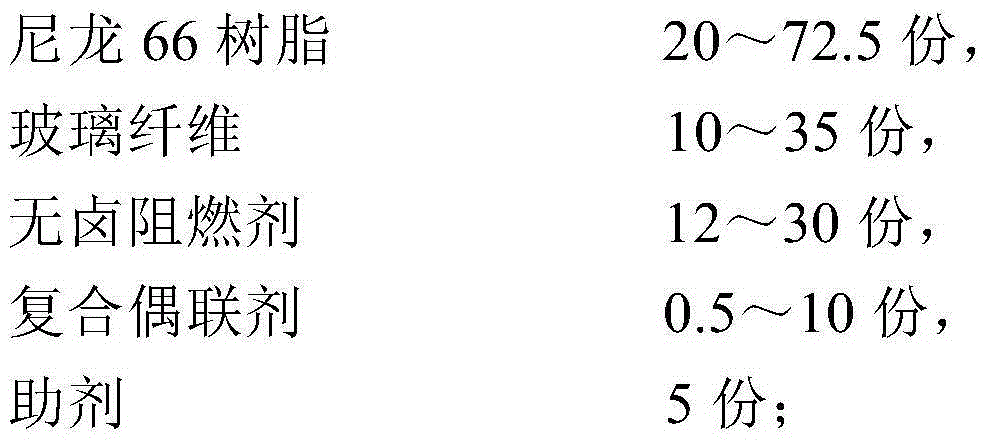Halogen-free flame retardant and glass fiber reinforced PA (polyamide) 66 composite material with acid and alkali resistance and preparation method of PA66 composite material
A flame-retardant glass fiber and composite material technology, applied in the field of new varieties of modified engineering plastics, can solve problems such as insufficient acid and alkali resistance, and achieve the effects of overcoming the insufficient acid and alkali resistance, good processing fluidity, and excellent mechanical properties
- Summary
- Abstract
- Description
- Claims
- Application Information
AI Technical Summary
Problems solved by technology
Method used
Image
Examples
Embodiment 1
[0035] (1) Add 12 parts of ammonium polyphosphate and 6 parts of zinc borate into the high-speed mixer and stir for 10 minutes, add 0.1 part of KH550, continue stirring for 2 minutes, add 46.5 parts of PA66 resin, and 5 parts of other various additives and 0.4 parts of composite coupling agent (0.15 parts of KH550, 0.25 parts of KH560) were stirred by a high-speed mixer for 4 minutes and then taken out to obtain the mixture;
[0036](2) Put the mixture obtained in step (1) into the main feed, adjust the number of glass fiber strands to control the glass fiber content to 30 parts, extrude through a twin-screw extruder, draw strands, cool, pelletize, and dry The speed of the main screw is 240 rpm, and the temperature of each section of the extruder is 235°C, 270°C, 275°C, 270°C, 270°C, 265°C, 260°C, 260°C from the feeding port to the die head. °C, 265 °C;
[0037] (3) Injection mold the masterbatch into a standard sample, the injection temperature ranges are 270°C, 270°C, 265°C...
Embodiment 2
[0041] (1) Add 16 parts of melamine phosphate, 5 parts of zinc borate and 3 parts of talcum powder into the high-speed mixer and stir for 10 minutes, then add 0.1 part of KH550, continue stirring for 5 minutes, then add 57.15 parts of nylon 66 resin, 5 parts of other various additives, 0.25 parts of KH550, 3.5 parts of epoxy resin (molecular weight: 2000) were taken out after a total of 6 minutes of stirring in a high-speed mixer;
[0042] (2) Put the mixed material obtained in step (1) into the main feed, adjust the number of glass fiber strands to control the glass fiber content to 10 parts, extrude through a twin-screw extruder, draw strands, cool, pelletize, and dry Processing; the main screw speed is 190 rpm, and the temperature of each section of the extruder from the feeding port to the machine head is 235°C, 265°C, 270°C, 265°C, 265°C, 265°C, 260°C, 260°C, 260°C;
[0043] (3) The masterbatch was injection molded into a standard sample, the injection molding temperatur...
Embodiment 3
[0047] (1) Add 9 parts of melamine and 9 parts of phosphinate into a high-speed mixer and stir for 10 minutes, add 0.1 part of KH550, continue stirring for 2 minutes, add 37.7 parts of nylon 66 resin, and other various additives 5 parts, 0.20 parts of KH550, 4 parts of epoxy resin (molecular weight is 10000) take out after stirring in a high-speed mixer for 5 minutes;
[0048] (2) Put the mixed material obtained in step (1) into the main feed, adjust the number of glass fiber strands to control the glass fiber content to 35 parts, extrude through a twin-screw extruder, draw strands, cool, pelletize, and dry Processing; the main screw speed is 260 rpm, and the temperature of each section of the extruder is 240°C, 275°C, 275°C, 270°C, 270°C, 265°C, 265°C, 265°C, 270°C;
[0049] (3) Injection mold the masterbatch into a standard sample, the injection molding temperature is 275°C, 270°C, 270°C, 265°C respectively, and the injection mold temperature is 90°C.
[0050] (4) Place 10...
PUM
| Property | Measurement | Unit |
|---|---|---|
| diameter | aaaaa | aaaaa |
| diameter | aaaaa | aaaaa |
Abstract
Description
Claims
Application Information
 Login to View More
Login to View More - R&D
- Intellectual Property
- Life Sciences
- Materials
- Tech Scout
- Unparalleled Data Quality
- Higher Quality Content
- 60% Fewer Hallucinations
Browse by: Latest US Patents, China's latest patents, Technical Efficacy Thesaurus, Application Domain, Technology Topic, Popular Technical Reports.
© 2025 PatSnap. All rights reserved.Legal|Privacy policy|Modern Slavery Act Transparency Statement|Sitemap|About US| Contact US: help@patsnap.com



